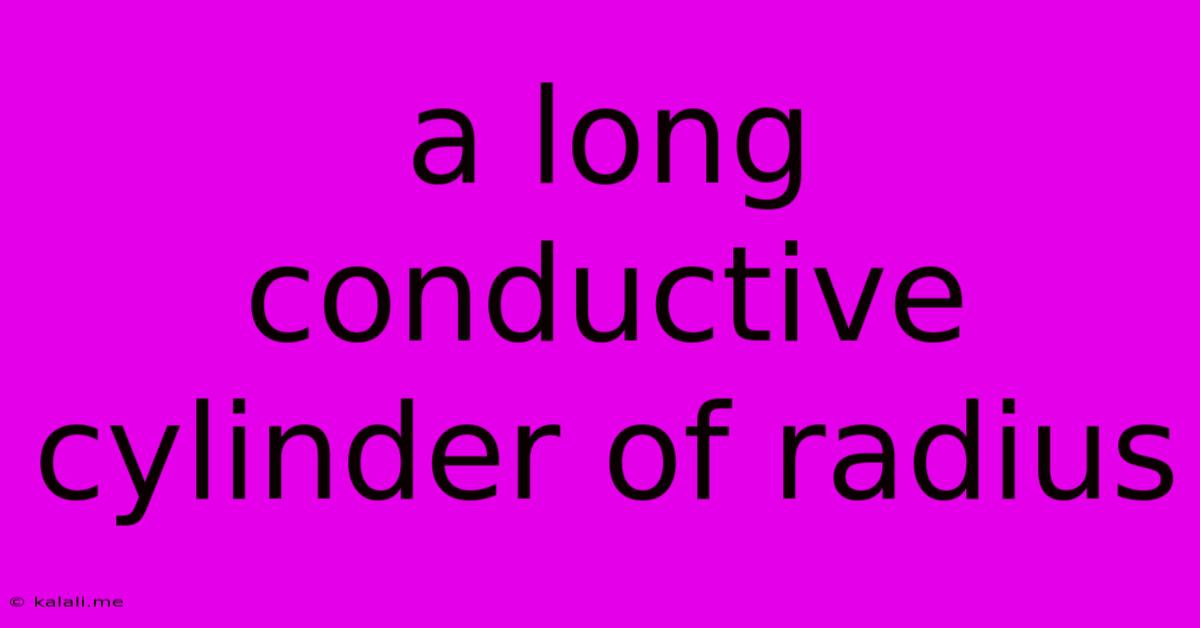A Long Conductive Cylinder Of Radius
Kalali
Jun 16, 2025 · 3 min read

Table of Contents
Electric Potential and Field of a Long Conductive Cylinder
This article delves into the calculation of the electric potential and electric field surrounding a long conductive cylinder carrying a uniform charge distribution. We'll explore the application of Gauss's law and the relationship between potential and field, providing a comprehensive understanding of this fundamental electrostatics problem. This is a crucial concept in understanding concepts like capacitance and shielding in electrical engineering and physics.
Understanding the Problem:
We're considering an infinitely long cylinder of radius 'a' carrying a uniform linear charge density λ (Coulombs per meter). We want to determine the electric potential V(r) at a radial distance 'r' from the cylinder's axis and the corresponding electric field strength E(r). The assumption of an infinitely long cylinder simplifies the problem significantly by allowing us to ignore end effects.
Applying Gauss's Law to Find the Electric Field:
Gauss's law states that the total electric flux through a closed surface is proportional to the enclosed charge. For cylindrical symmetry, a cylindrical Gaussian surface of radius 'r' and length 'L' is the ideal choice.
-
Inside the Cylinder (r < a): The Gaussian surface encloses no charge, resulting in zero electric flux and therefore, zero electric field: E(r) = 0 for r < a.
-
Outside the Cylinder (r > a): The Gaussian surface encloses a charge of Q = λL. Gauss's law gives us:
∮E⋅dA = Q/ε₀
Where:
- E is the electric field.
- dA is the differential area vector.
- Q is the enclosed charge.
- ε₀ is the permittivity of free space.
Due to symmetry, the electric field is radial and constant in magnitude on the Gaussian surface. This simplifies the integral to:
E(2πrL) = λL/ε₀
Therefore, the electric field outside the cylinder is:
E(r) = λ/(2πε₀r) for r > a
This shows the electric field strength decreases inversely with the distance from the cylinder's axis.
Calculating the Electric Potential:
The electric potential is the work done per unit charge in bringing a test charge from infinity to a point in the electric field. We can find the potential by integrating the electric field:
V(r) = - ∫∞ʳ E(r) dr
-
Outside the Cylinder (r > a):
V(r) = - ∫∞ʳ (λ/(2πε₀r)) dr = -(λ/(2πε₀)) [ln(r)]∞ʳ = (λ/(2πε₀)) ln(∞/r)
This integral diverges at infinity. To obtain a meaningful result, we define the potential at infinity to be zero and refer the potential to infinity. This gives us:
V(r) = (λ/(2πε₀)) ln(R/r) for r > a
where R is a reference radius, often taken to be a specific distance. The potential decreases logarithmically with distance from the cylinder.
-
Inside the Cylinder (r < a): Since the electric field inside is zero, the potential is constant and equal to the potential at the surface (r = a):
V(r) = (λ/(2πε₀)) ln(R/a) for r < a
Key Takeaways:
- The electric field inside a charged conductive cylinder is zero.
- The electric field outside the cylinder is inversely proportional to the distance from the axis.
- The electric potential outside the cylinder decreases logarithmically with distance.
- The potential inside the cylinder is constant.
This analysis provides a fundamental understanding of the electric field and potential distributions around a charged cylindrical conductor. This knowledge has applications in various fields, including capacitor design, high-voltage engineering, and the study of charged particle beams. Further explorations could involve considering non-uniform charge distributions or finite cylinder lengths, leading to more complex calculations.
Latest Posts
Latest Posts
-
How To Create Clickable Image In Html
Jun 16, 2025
-
What Are The Factors Of 121
Jun 16, 2025
-
What Is A Theme Of The Passage
Jun 16, 2025
-
A Company That Provides Access To The Internet
Jun 16, 2025
-
Which Word Is Closest In Meaning To The Underlined Word
Jun 16, 2025
Related Post
Thank you for visiting our website which covers about A Long Conductive Cylinder Of Radius . We hope the information provided has been useful to you. Feel free to contact us if you have any questions or need further assistance. See you next time and don't miss to bookmark.